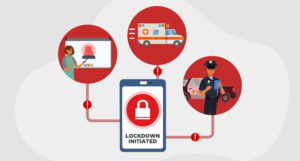Vaping remains a pressing concern in schools across the United States. While tobacco use among youth has seen an overall decline, e-cigarettes remain the most commonly used tobacco product among middle and high school students. According to the CDC, of students that reported current use of e-cigarettes, 38.4% reported frequent use and 26.3% reported daily use.
These trends raise concerns for educators, not only because of the well-documented health risks, but also because vaping often disrupts learning environments. Students frequently leave class to vape, and many incidents occur in restrooms, locker rooms, and unsupervised areas of campus.
Addressing student vaping involves far more than just enforcing disciplinary policies. It requires a coordinated response that includes prevention education, support services, and the right tools and technology.
Why Do Students Vape?
To effectively combat vaping, schools need to understand why students start in the first place. Research has shown that the most common reasons for adolescent vaping include:
- Flavor Appeal: According to the FDA, 87.6% of youth e-cigarette users report using flavored products, with fruit, candy, mint, and menthol being the most popular.
- Social Influence: Many students start vaping because they see peers doing it or because it is glamorized on social media.
- Perceived Stress Relief: Some students turn to nicotine as a way to cope with anxiety and school pressures.
Without addressing the underlying reasons students vape, suspensions and fines alone won’t stop the cycle.
Where Are Students Vaping in Schools?
Students often capitalize on locations that afford privacy or limited supervision, making prevention and detection difficult.
- Bathrooms
These are the most common locations for vaping due to the privacy provided by stalls. - Secluded campus areas
Locations like behind portable buildings or athletic facilities offer concealment and reduce risks of being caught. - Classroom breaks
Some students plan vaping meetups during strategic class exits, further challenging monitoring efforts.
Monitoring and preventing vaping in these spaces presents considerable challenges for school staff. The sheer size of school campuses and the multitude of potential vaping locations make it difficult to effectively patrol and enforce anti-vaping policies.
The discrete nature of vaping devices, which often resemble everyday items like USB drives, also makes it difficult to confiscate these devices once they are in the building.
Developing proactive strategies to prevent vaping takes a comprehensive approach.
How to Prevent Students from Vaping in Schools
Preventing vaping involves a mix of education, supportive tools, and collaborative action. Schools can adopt these strategies to effectively address the issue:
1. Education and Prevention Programs
Provide access to resources such as posters, presentations, and workshops to raise awareness about the dangers of vaping and encourage open dialogue about vaping risks. Provide students access to counseling, support groups, and other programs to help them quit vaping.
Organizations like the American Lung Association and Truth Initiative offer educational resources that are great for schools, including quit-vaping apps and text message support programs.
2. Staff Training
Train staff on the dangers of nicotine addiction in teens and the health risks of e-cigarettes as well as how to recognize signs of vaping. Provide training on prevention strategies to keep students safe from harmful substances.
3. Early Intervention
Have a secure and easy way for staff to be able to quickly document any concerns they have for a student that may be struggling with substance abuse. Ensure that information is accessible to the appropriate team members, like the nurse or school counselor, so students can get the support they need.
4. Technology and Digital Solutions
By combining school policy and student education with technology and digital solutions, schools can create a safer environment and reduce vaping incidents. For example:
- Technology such as vape detectors helps support and enforce school policies and regulations regarding vaping. These devices are increasingly being installed in schools to detect vaping activity and deter students from vaping on campus.
- A digital hall pass system enables teachers and administrators to monitor student movement in the building, such as how many times a student has requested a pass, when they left a classroom, the intended destination, and their return to class. This information can be used to identify which students were in the bathroom when vape detectors were activated. Additionally, advanced digital hall pass solutions can be used to automatically block students from leaving their classrooms at the same time if they are known to meetup and vape together.
- Anonymous tip lines are also powerful tools. By allowing students to report incidents without fear of retaliation, schools can quickly address and prevent vaping, creating a safer and healthier environment for all students.
Empower Your Schools with Smarter Vaping Prevention
Effective vaping prevention isn’t just about rules—it’s about equipping your schools with the right tools and strategies to succeed.
Raptor can help. Take the first step in creating a healthier, safer learning environment. Schedule a demo.
Related Resources





